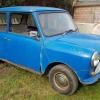The bonnet soundproofing used on early Mini's and Clubmans was removed in later years as part of the later cost reductions.
Available from Somerfords:
https://www.somerfor...age=page&id=139
Sound Insulating Felt
Somerford Mini have acquired the stocks of original 1990s Mini sound insulating felts from the Rover parts organisation, XPart. These felts are all factory precision die-cut for specific areas of the bodyshell, including bulkheads, inner wings, toeboard, dash, sills and footwells and most feature cut-outs and holes for equipment found on each model. As a result, there are several variations of each felt - too many to list here! If you require original factory insulating felts for your Mini, please contact us for details.
We hold a choice of three under-bonnet soundproofing products, each coated with fire-retardant facings and intended to be applied with trim adhesive to the underside of the bonnet:
Sound Insulation
Many attempts have been made over the years to reduce the cabin noise in the Mini, with varying degrees of success; none have quite removed that 'bouncing along in a bean can' sensation we all know and love (?) so well. Two attempts stand out particularly. The first, after the demise of the 850 saloon in 1980, involved stuffing large amounts of sound deadening material onto the floors (replacing the hessian backing on the carpets), in the companion boxes, on the dash and on the roof. Triumphantly labelled 'The Quiet Mini' by the marketing department, it sort-of worked. Can any of you really tell the difference, though?
The other serious, and ultimately more successful, anti-noise campaign took place during the development of the 1997 on model. One of the forthcoming European regulations that had to be passed if the Mini was to stay in production after 1997 was the drive-by noise limit - i.e. the aural impact the car would have on its immediate environment. Once again, sound deadening material was beefed up, but it still required exhaust modifications, the repositioning of the radiator to the front of the car and the raising of the final drive ratio (so the engine wasn't running so fast) plus a host of other changes to get the Mini quiet enough to pass the tests. It did pass, obviously, and the 1997 on Minis are genuinely noticeably quieter both from the outside and inside. Only one other Rover Group product had to turn similar engineering cartwheels to pass the drive-by noise test: the Land Rover Defender. Says it all, really...
Sound insulation material in the Mini takes two forms - bitumen self-adhesive pads affixed to the insides of the larger panels to prevent them from drumming, and thick felt or foam sheets against both sides of the dash and on the floors. Leave them out at your peril - the noise level in an uninsulated Mini is astonishingly loud.
The fire retardent felt engine bay dash pads we stock are rationalised from the original countless variations down to two. The 1959-69 dash pad is tailored for inboard bonnet hinges, early (square) wiper motor mounting and the fresh air duct passing through the dash that many Minis of that period had fitted. The 1969 on dash pad is cut to the correct outline but leaves the job of tailoring for the myriad of dash mounted equipment fitted from 1969 on up to the customer - which is no huge task, because the majority fix by screws through the dash pad anyway.
We can also supply additional quantities of insulating felt from bulk stock. It is sold by the square metre, from a 1 1/2 metre wide roll (i.e. if you ask for one square metre you will get a rectangle of felt 1 1/2 metres by 2/3 metre). It can be used for any interior or boot application, common uses (other than floors, which are covered by our underlay set) being:
Lower dash (under parcel shelf) Upper dash (above parcel shelf, behind dash liners)
Pair of front wheel arches
Boot floor (originally used on more upmarket 1959-75 models)
Underside of rear parcel shelf (originally used on 1959-69 models)
Offcuts can be used in the companion boxes, which were also felt insulated in the factory.
Sound Deadening Pads
The CHM228 sound deadening pad is an industry-standard product used by motor manufacturers for many years. It is designed to prevent vibration in large expanses of sheet metal which would otherwise drum when the car is in use. Following factory practice, application of pads around the body should be as follows: one inside each door skin, one inside each rear quarter panel, two inside the roof, one in each front footwell, one in each rear footwell, two on the centre tunnel and two on the rear seat pan.
Being bitumen based, sound deadening pads are extremely brittle when cold. Even on a warm day they should be carefully heated with a hot air gun or similar until they are sufficiently ductile to follow the contours of the panels to which they are being applied. They can be made to follow extreme contours such as deep floor ribs using heat - something you wouldn't believe when the pads are cold. One final word of advice - if your Mini body is due to be painted in an oven, don't apply sound deadening pads to the roof until afterwards, unless you want a really painful job chipping all the melted bits (by this time set rock-hard) off the floor and rear seat area.
Edited by mab01uk, 02 November 2013 - 04:35 PM.


















